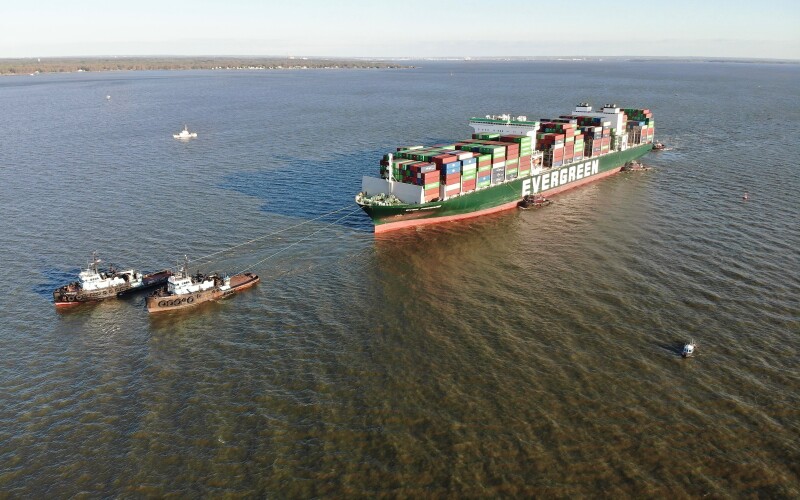Some 147 million juvenile oysters will be planted on an upper Chesapeake Bay oyster bar where the container ship Ever Forward ran aground in 2022, the Maryland Department of Natural Resources announced Friday.
The 41 acres of bottom in Anne Arundel County waters are where the 1,095-foot ship ran aground March 13, 2022 while outbound from the port of Baltimore, getting stuck inside the state-designated Natural Oyster Bar 4-2. The Ever Forward, which was drawing 40 feet of water, plowed into the bottom at a depth of 18 feet, according to DNR officials.
In its report on the accident, the Coast Guard found that the Maryland state pilot guiding the Ever Forward was distracted by his cell phone use hours before the grounding. The report also faulted the Ever Forward bridge crew; investigators summarized “the incident’s causal factors to be the pilot’s failure to maintain situational awareness and attention while navigating, and inadequate bridge resource management.”
The grounding led to an extended drama with the ship stranded for more than a month, as a unified command of the Coast Guard, Maryland Department of the Environment, and Evergreen organized a massive salvage plan to free the ship. Dredging, cargo lightering, and complex towing plans all had to be used before the Ever Forward finally floated free on April 17.
In January 2023 Maryland required Evergreen to pay DNR $676,200 in to fund oyster bar seeding mitigate the event’s impacts.
“It was unfortunate that the Ever Forward ran aground in the area of a protected oyster bar, but we’re glad to see that remediation from that grounding will go directly to helping oysters in the Bay,” DNR Assistant Secretary for Aquatic Resources Kristen Fidler said in announcing the site selection. “This new planting of oyster spat will be beneficial to the oyster industry and ongoing restoration efforts in Maryland.”
The grounding directly impacted about 14 acres of Chesapeake Bay bottom, including 11.5 acres within the boundary of a natural oyster bar, according to the Maryland Board of Public Works.
According to stipulations imposed on the Evergreen settlement, DNR will plant 60 million spat in designated sanctuary waters, where no oyster harvesting is allowed, and 87 million spat in oyster industry areas.
“Although the ship was lodged in a public fishery bar, Maryland included the seeding of both sanctuary and wild fishery locations to align with Maryland’s commitment to the ecological and economic importance of the oyster population,” according to DNR officials.
After meetings with oyster stakeholders in Anne Arundel County, DNR selected Herring Bay Sanctuary as the location for the sanctuary spat.
“This site has abundant habitat to accommodate all 12 acres of the planned sanctuary mitigation and adequate water salinity for oyster survival and reproduction. A portion of this sanctuary is in an area labeled as “depleted” in the 2022 stock assessment. The planting will enhance that area,” according to the agency.
“These mitigation spat add another dimension to the existing excitement for and dedication to sanctuary oysters among the river organizations and general public in Anne Arundel County,” said Department of Natural Resources Shellfish Division Director Christopher Judy. “The 12 acres in the Herring Bay sanctuary will yield a sizable population of oysters and broodstock. DNR looks forward to working with the Advocates for Herring Bay, a strong partner in the area.”
Locations for the 29 acres of public fishery oyster plantings will be determined in coordination with the Anne Arundel County Oyster Committee during DNR’s annual planning meeting with commercial oyster operators in February.
In the next few months, DNR will plan details of hatchery production and planting for both the sanctuary and public fishery spat, which will be seeded in the Bay in summer 2024 and into 2025, if needed.







